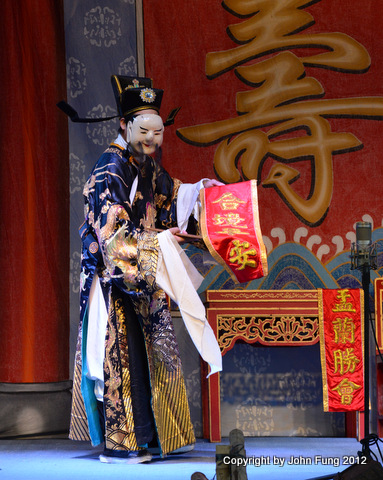盂蘭勝會 The Ghost Festival (Ullambana)
也許是年紀大了, 愈來愈相信「萬事皆有其緣法」這回事, 就連参觀盂蘭勝會也是个緣字。在香港那些年, 每天除了忙, 還是只有忙。每年的農曆七月, 經過盂蘭勝會的場地 (多在社區球場搭建), 見到大士台內青面獠牙的紙紥神像, 都會貪婪的多看两眼,心裡老是謫詁着要找個時間去拍照。今年第二次回港正好碰上農曆七月, 知道沙田禾輋邨有盂蘭勝會, 會場離酒店一箭之遥, 走路就能到。那天下午有個空檔, 雖然晚上才演戲, 但晚上有事, 所以也就信步走去, 隨便看看。到達時快四點了, 卻沒想到來的正是時候呢。
The Ghost Festival, also known as the Hungry Ghost Festival, is widely observed in Asia, from Japan, Korea, China, Vietnam to Malaysia, in a variety of forms and rituals. The festival is held on the 15th of the 7th month on the lunar calender (14th in southern China, and most Japanese use Gregorian calender nowadays). A lot of rituals and offerings to ghosts are carried out through out the whole seventh month. It is believed that the festival had its origin in Ullambana (note the first two or three phonetic segments = Yu Lan or Yu Lan Pan in Chinese) and the assumption of the annual opening of the gates of hell. Unlike other Chinese memorial days, Qingming and Chung Yeung in which offerings are only made to family ancestors, in Yu Lan offerings are made to all souls, including the wandering souls who have no one sending offerings to them.
 記得小時候, 每至農曆七月, 街上有人燒”街衣”, 設食祭祀, 普渡孤魂野鬼。六O年代後就多見有組織的孟蘭勝會在各區舉行, 似為潮汕籍同胞的風俗。盂蘭勝會又稱盂蘭盤會(曰人稱之為盂蘭盤或お盤), 據說緣自<佛說盂蘭盆經,Ullambana>「目連救母」的故事, 那印度故事後來被漢化成國劇劇目。普通賀誕的神功戲只有戲棚, 孟蘭勝會除了戲棚外, 還有神壇、經棚和大士台等好幾座棚, 以進行不同的活動。
記得小時候, 每至農曆七月, 街上有人燒”街衣”, 設食祭祀, 普渡孤魂野鬼。六O年代後就多見有組織的孟蘭勝會在各區舉行, 似為潮汕籍同胞的風俗。盂蘭勝會又稱盂蘭盤會(曰人稱之為盂蘭盤或お盤), 據說緣自<佛說盂蘭盆經,Ullambana>「目連救母」的故事, 那印度故事後來被漢化成國劇劇目。普通賀誕的神功戲只有戲棚, 孟蘭勝會除了戲棚外, 還有神壇、經棚和大士台等好幾座棚, 以進行不同的活動。
Ullambana origin – As described in the Sutra, the mother of Maudgalyayana, a disciple of Buddha, was suffering from the lower realm. Lord Buddha instructed Maudgalyayana to obtain liberation for his mother by making offering to the sangha, the community of monks, and the hungry ghosts. However, Yu Lan is not considered to be a major festival by most Cantonese except for folks from Cháozhōu (or Chiuchow 潮州). As a matter of fact, almost all the celebration in different communities are organized by folks from Chaozhou. The opera performed on stage is mostly in Chaozhou style and dialect, although occasionally Cantonese opera companies are also hired to perform because a lot of the young folks do not speak their dialect anymore. To the older generation, Ullanbana is much more than opera, there are rituals and offerings as reflected by the number of bamboo halls in the premises.
1. 經師棚 : 經師在此設壇誦經, 超度亡魂。在沙田孟蘭勝會所見, 經師棚雖掛念佛社之幡, 但經師似為道教中人。這也跟中元節的融合佛、道ニ教, 普渡陰陽ニ界的傳統吻合。
1. Ceremony hall where Buddhists or Taoists hold ceremonies to relieve ghosts from suffering. The following two photos show the ceremony hall and setting inside the hall. Taoists were chanting inside the hall, apparently performing some sort of ceremonies.
2.神棚: 棚內設供拜「天地父母」和緒神。神棚两側相連為辦事處和接待室。
2. The shrine: There were a number of gods enshrined here, among them, the God of Heaven and Earth. Next to the shrine were the office and reception room.
3. 大士台, 孤魂台和福品台。
3. Guanyin (Bodhisattva) Hall (right), on the left,Wandering Ghost Hall & Lucky rice stand.

大士,傳說是觀音化身成鬼王, 於鬼月中統領和安撫孤魂野鬼。 This god is believed to be one of the embodiments of Bodhisattva Guanyin (Goddess of Mercy) who acts as the leader of wandering ghosts and spirits during the ghost’s month.
福品台 – 主要是白米, 另外還有各種由善信捐贈作競投的各樣物品. 據說今年一條十包裝的 Lucky 香煙以港幣三萬八千元投得。
Next to the stable of the Red House, there was a stand for stacking lucky food, mainly rice, for later distribution to neighbors who believed eating those rice would bring good luck to their families .
5. 戲棚: 戲棚結構與西貢白沙湾神功戲戲棚相若, 只是觀眾席設在地上, 並無微斜的台而已。
5. The theater, where the devotional opera performance was held.
5. 神袍棚: 神棚內擺放神袍三件, 分別是「天地父母」袍, 「南辰北斗」袍, 和「諸位福神」袍, 此外另有較小型的神衣和金銀元宝等貢品..
5. Outfit for deities. These beautiful and delicate paper outfit were for deities, they would be burned with the embodiment of Bodhisattva Guanyin before the end of the 3-day event.

***************************************************************************************
儀式 Ceremony :
道士誦經超度亡魂。 Chanting by Taoists to relieve suffering of the wandering ghosts.
正在跟拍道士唸經的時候, 突然聽到鼓樂大鳴, 原來戲台上鼓樂動起來, 正上演「五福連」, 所以說來得正是時候,運氣太好了。中國傳統戲劇上演前多有開台吉祥戲(見白沙湾神功戲), 潮劇之吉詳戲為”四出連”(四齣連?), 共產黨上台後就被禁演, 直至80年代開放後才恢復, 並根據神功戲呈現”功名財子壽”的寓意而改稱為”五福連”,是一組片段式的組合演出。
While taking pictures of the ceremony in front of the Wandering Ghost Hall, I heard music playing in the theater. Out of blue, auspicious scenes were being played.
第一齣: 十仙慶寿, 又稱八仙賀寿。與粵劇六國大封相前的八仙賀寿有明顯不同, 此處重點在於將十仙擺成壽字。十仙者, 即傳統八仙加東方朔和金母(西天王母娘娘)也。
Auspicious Scene 1: Celebrating Empress of Heaven’s birthday by the Eight Immortals (八仙). The devotional Cantonese opera we’d seen in Sai Kung also had the same scene. However, the Chaozhou version was performed in a different way. The scene is a symbol of longevity.
第二齣: 跳加冠- 加冠亦即加官, 加官晉爵也。粵劇的開台吉祥戲碼是八仙賀寿和六國大封相, 好像沒有跳加官。而京劇的舊傳統是有跳加官的, 尤其是有達官貴人蒞臨。尤有進者, 如果有貴介夫人出席看戲, 會加跳”女加官”。台湾歌仔戲亦有跳加冠的吉祥戲。又記, 據說現在香港潮劇團後繼無人, 很多劇團成員都是來自福建云云。表演者扮相似天官, 亦有人說是財神趙公明。
Auspicious Scene 2: Auspicious dance by a court official, a symbol of promotion.
以前戲班演戲中, 如有達官蒞臨, 戲即暫停。由穿官服的演員演跳加官歡迎高官, 由於是突發性的, 要換裝有困難, 所以演員所”帶”之面具很特別, 面具後有一籐條, 演員用口咬着, 馬上可出台。由於跳加官沒有台詞, 而表演也是數分鐘的事, 所以是有效率的安排。此傳統沿用至今。
第三齣 : 落地送子 – 故事是凡人董永與天姬結合。天姬後被逼回天宫, 誕下麟兒。於是特駕雲下凡向董永送回骨肉。
Auspicious Scene 3: Delivery of baby boy. It is a story of a young court official who fell in love with a beautiful deity. She was later forced to go back to heaven. A baby boy was born in heaven and the deity mother came down to earth again to deliver the baby to his father. This is a symbolism of offspring.

落地送子之稱之為落地就是所有有演員由中間梯級步行至神壇向天地父母跪拜。The tradition in this Chaozhou version is to walk down the staircase and go the shrine to make a wish.
第四齣 : 唐明皇淨棚, 亦有稱李世民淨棚 (實為李隆基之誤)。唐明皇獨自出場, 用孔子正音唸四句韵白, 曰:「高搭彩樓巧艳戕, 梨園子弟有萬千,句句都是翰林造, 奏出離合共悲歡」。語畢, 向四方表演身段, 然後退場, 過程不過三數分鐘。
Auspicious Scene 4 : The actor enacted as Emperor Lee of the Tong Dynasty. The emperor performs a ritual to clarify the stage before the actual performance.
第五齣 京城會。演述呂蒙正高中,接夫人劉翠屏到京相會團圓的故事。
Auspicious Scene 5: Family Reunion.
開台吉祥戲至此告一段落,晚上正式開鑼上演神功戲。
Auspicious Scene ended here, it lasted only 45 minutes. The real show would begin at 8pm, I had obligation that night, so I went back the last evening of the 3-day event.
後記: 此舞台的佈置相當不錯, 佈景、道具、服装和樂師都有劇團水平, 唯一令我困擾的是他們的照明。舞台上照明極不平均, 而且光源色温亦不一致, 演員站立的每一個位置的曝光指數都不一樣, 身體稍為移動, 效果就变了, 挑戰性很大。
Note: Although it was a free performance, the costume, stage setting and the orchestra were up to standard. However, the only challenge, in terms of picture taking, for me was the lighting. The stage was not evenly illuminated, and spot lights of different color temperature were used, making proper exposure very difficult.






























































































































































































































































































































































































































































































































































































































































































































































































